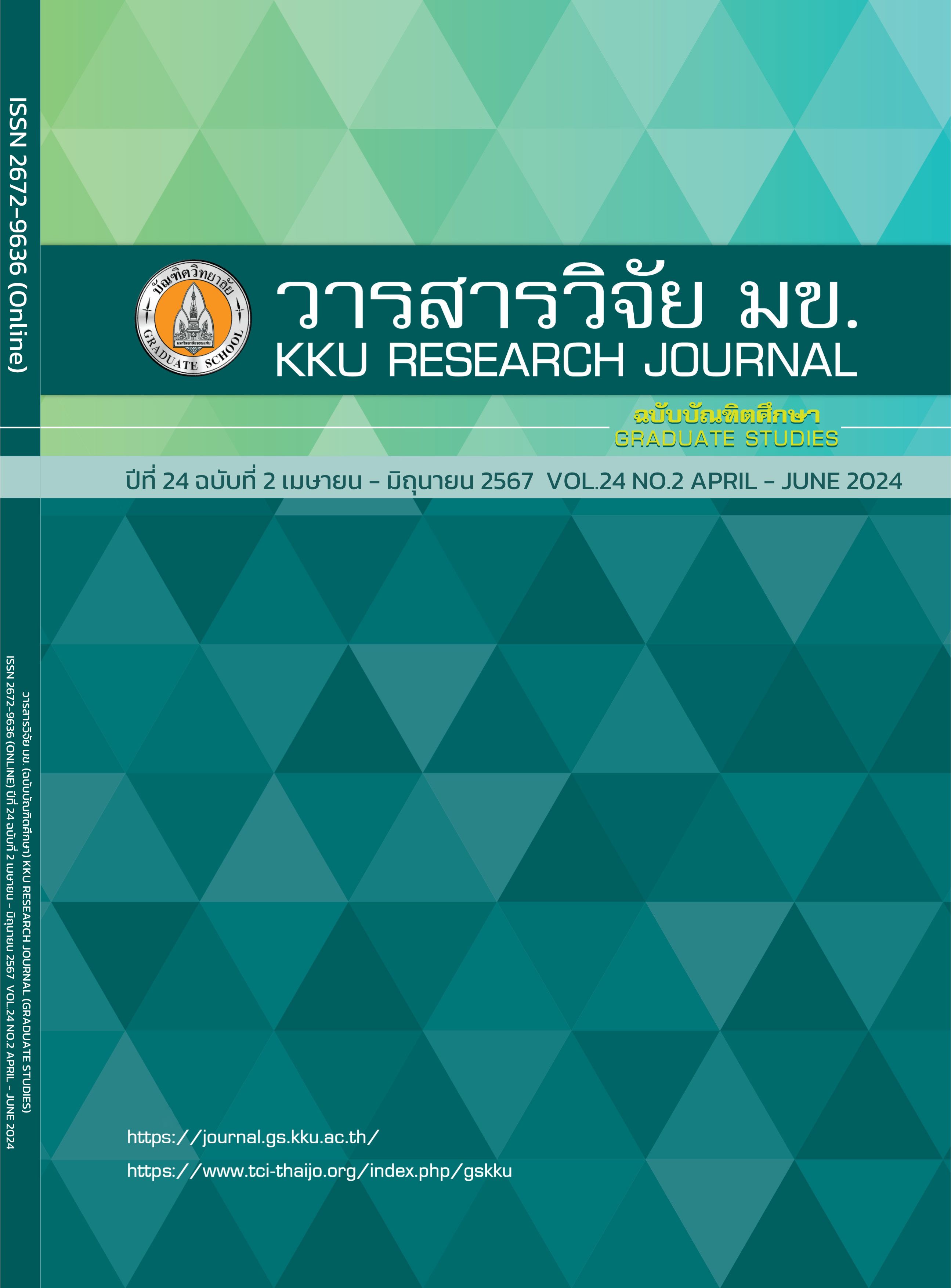The Study of Movement Behavior of Brick Block Retaining Wall Reinforced by Wire Stand
Keywords:
Retaining wall, Interlocking brick, Wire standAbstract
This paper presented the movement behavior of a dry-joint interlocking brick retaining wall reinforced with wire ropes in diameter size is 4 mm under the tensile strength of 4.54 9.07 and 13.61 kilograms. The interlocking bricks had dimensions of 12.5x25x10 cm. and weigh 15 kg/block. Compressive strength 80.51 kg/cm2. To study the behavior of horizontal displacement of its, had height 1.50 m width 2.00 m thickness 0.125 m. The dry-joint interlocking brick retaining walls for both permanent and temporary walls was simple, convenient and fast for construction without requiring skilled labours and large machinery. The experiment found that the interlocking brick retaining wall reinforced with 4 mm. of diameter wire ropes under 4.54, 9.07 and 13.61 kilograms. of many tensile forces had the maximum horizontal displacement of 4.06 4.27 and 4.55 mm., respectively, and the modulus of elasticity values was 140,441 111,262 and 78,325 kg/cm2 respectively. And compared the behavior of its under conditioner above – mentioned, found the structure of its had maximum efficiency under tensile forces 4.54 kilograms with this condition it had the most straight line of displacement and had the least horizontal displacement to shows that under tensile forces 4.54 kilograms with wire ropes in diameter size 4 mm. was the suitable force per section area of wire ropes in diameter 4 mm. to result in of retaining wall had a high resistance from lateral earth pressure. This cased was the best to apply for the dry-joint interlocking brick retaining walls when comparison with other cares in condition under tensile forces 9.07 and 13.61 kilograms there are showed the percentage of displacement values were 5.17 and 12.0 respectively.
References
Ketkan W, Khamphala A. A Model of Maximum Pullout Force of Bearing Reinforcement Stabilized on Compacted Sandy Soil. RMUTI Journal Science and Technology. 2010; 3(1): 1-9.
Colas AS, Garnier D, Morel JC. Yield Design Modelling of Dry Joint Retaining Structures. Construction and Building Materials. 2013; 41: 912-917.
Tanakrit B, Attaphol B, Sorasak S, Pongsagorn P. Strength and Behaviors of Dry-Joint Retaining Nano-Block. Proceedings of the 22 National Convention on Civil Engineering. 2017; 338-345.
MSU 602/2547. Community product standard. Thai Industrial Standards Institute, Thailand; 2004.
Gao J, Liu L, Zhang Y, Xie X. Deformation Mechanism and Soil Evolution Analysis Based on Different Types Geogrid Reinforced Foundation. Construction and Building Materials. 2022; 331: 127322.
Rahmaninezhad SM, Han J. Lateral Facing Deflections of Geosynthetic-Reinforced Retaining Walls Under Footing Loading. Transportation Geotechnics. 2021; 30: 100594.
Prongmanee N, Noulmanee A. Properties of Chiang Khruea Lateritic Soil and Their Applications in Civil Engineering. RMUTI Journal Science and Technology. 2020; 13(3): 14-30.
Li LH, Yu CD, Xiao HL, Feng WQ, Ma Q, Yin JH. Experimental Study on the Reinforced Fly Ash and Sand Retaining Wall Under Static Load. Construction and Building Materials. 2020; 248: 118678.
Arefnia A, Dehghanbanadaki A, Kassim KA. Sustainable Implementation of Recycled Tire-Derived Aggregate as a Lightweight Backfill for Retaining Walls. KSCE Journal of Civil Engineering. 2021; 25(11): 4196-4206.
Wang JQ, Zhang LL, Tang Y, Huang SB. Influence of Reinforcement-Arrangements on Dynamic Response of Geogrid-Reinforced Foundation Under Repeated Loading. Construction and Building Materials. 2021; 274: 122093.
Liu S, Fan K, Xu Si. Field Study of a Retaining Wall Constructed with Clay-Filled Soilbags. Geotextiles and Geomembranes. 2021; 47(1): 87-94.
Villemus B, Morel JC, Boutin C. Experimental Assessment of Dry Stone Retaining Wall Stability on a Rigid Foundation. Engineering Structures. 2007; 29(9): 2124-2132.
Bubpi A, Sirisriphet Y, Amornpinyo P, Tho-In T, Yodsiri P, Poungchompu P. Behavior of Nano Block Retaining Walls Reinforced with GFRP Bars. RMUTI Journal Science and Technology. 2022; 15(3): 85-95.
Bubpi A, Amornpinyo P, Teerawong J. Comparison of Retaining Walls from Half-Panel Interlocking Bricks with Dry Joints Reinforced with GFRP Material and Stud Steel. RMUTI Journal Science and Technology. 2022; 15(2): 107-117.
Nanni A. North American Design Guidelines for Concrete Reinforcement and Strengthening using FRP: Principles, Applications and Unresolved Issues. Construction and Building Materials.2003; 17(6): 439-446.
Hamzeh L, Hassanein A, Galal K. Numerical Study on the Seismic Response of GFRP and Steel Reinforced Masonry Shear Walls with Boundary Elements. Structures. 2020; 28: 1946-1964.
Ceroni F, Cuzzilla R, Pecce M. Assessment of Performance of Steel and GFRP bars as Injected Anchors in Masonry Walls. Construction and Building Materials. 2016; 123: 78-98.
Yang KH, Byun HY, Ashour AF. Shear Strengthening of Continuous Reinforced Concrete T-Beams Using Wire Rope Units. Engineering Structures. 2009; 31(5): 1154-1165.
Misnon NA, Giaretton M, Ingham J, Dizhur D. Pull-Out Behaviour of Near Surface Mounted Steel Wire Rope Bonded to Clay-Brick Masonry. Structures. 2021; 29: 119-210.
Yang KH, Joo DB, Sim JI, Kang JH. In-Plane Seismic Performance of Unreinforced Masonry Walls Strengthened with Unbonded Prestressed Wire Rope Units. Engineering Structures. 2012; 45: 449-459.
Yang KH, Byun HY, Ashour AF. Shear Strengthening of Continuous Reinforced Concrete T-Beams Using Wire Rope Units. Engineering Structures. 2009; 31(5): 1154-1165.
Pongsagorn P, Tanakrit B, Attaphol B. Strength and Behaviors od Dry-Joint Retaining Nano-Block. International Journal of Geomate. 2019; 16(54): 42-48.
Colas AS, Moral JC, Garnier D. Full-scale field trials to assess dry-stone retaining wall stability. Engineering Structures. 2010; 32(5): 1215-1222.
Downloads
Published
Issue
Section
License
Copyright (c) 2024 KKU Research Journal (Graduate Studies)

This work is licensed under a Creative Commons Attribution-NonCommercial-NoDerivatives 4.0 International License.



